High Protein Caramel Pudding*** - Ehrmann - 200 g
This product page is not complete. You can help to complete it by editing it and adding more data from the photos we have, or by taking more photos using the app for Android or iPhone/iPad. Thank you!
×
Barcode: 4002971303506 (EAN / EAN-13)
Quantity: 200 g
Packaging: Plastic, Pp-polypropylene
Brands: Ehrmann
Categories: Desserts, Puddings
Labels, certifications, awards: Low or no fat, Low fat, No gluten, Source of proteins, High proteins, No added sugar, No lactose, With sweeteners
Manufacturing or processing places: Germany
Traceability code: DE SN 006 EG, DE BY 77727 EG
Stores: K-market, Continente, K-Supermarket
Countries where sold: Finland, Italy, Portugal, Spain, Sweden
Matching with your preferences
Health
Ingredients
Food processing
Additives
Ingredients analysis
Nutrition
Environment
Packaging
Transportation
Report a problem
Data sources
Product added on by kiliweb
Last edit of product page on by october-food-facts.
Product page also edited by acuario, foodless, inf, jumati, marunsky, moon-rabbit, musarana, mvainola, openfoodfacts-contributors, packbot, roboto-app, sbrudersohn, scanbot, yuka.BIBbMIOCGv4jNsT89d0lxjm3PeX9L-VWB1ssog, yuka.CbxwN8aXBukAEMjW9oAV32O2MP3rJ8ZWMidWow, yuka.H69GB_6SIsYsTcLS3YwaxiOdOMq8G_h9R3ANoQ, yuka.Lqx7bIeXT_MBF8KK15kExgGwCtmwEfVJQmRRog, yuka.XZ1NbeOnDpUQPfXxyqUPzCiSG8LLOfpmEkAkow, yuka.ZDRjK0RZNEx0K1Uxb2ZJbThEcnEzL3RwbVlMeVZEeTdFczlQSUE9PQ.





